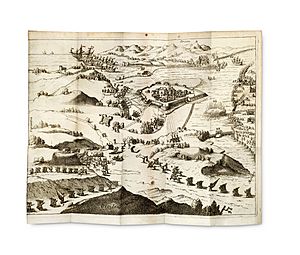Siege of Fuenterrabía (1523–1524) facts for kids
Quick facts for kids Siege of Fuenterrabía |
|||||||
|---|---|---|---|---|---|---|---|
| Part of the Italian War of 1521–26 | |||||||
 |
|||||||
|
|||||||
| Belligerents | |||||||
| Commanders and leaders | |||||||
The siege of Fuenterrabía happened in 1523. During this time, a combined army from France and Navarre took control of the city. This happened after an earlier attempt to take back the Kingdom of Navarre had failed. Navarre had been taken over in 1512 by soldiers from Crown of Castile and Crown of Aragon, with some Navarrese support. Interestingly, Navarrese people fought on both sides during this conflict.
In the 1500s, Fuenterrabía was a larger area. It included parts of what are now the cities of Irun, Lezo, Hendaye, Urruña, and Pasajes. The city and its strong fortress were built on a hill. Thick walls, mountains, and the sea surrounded it at the mouth of the Bidasoa River.
Because of its location on the border, Fuenterrabía was very important. Both Charles V, Holy Roman Emperor and Francis I of France wanted to control it. To protect against invasions, a castle was built in Behovia in 1512. This castle helped make the Fuenterrabía fort even stronger.
In early October 1521, French troops took the castle of Behovia. They were led by Admiral Guillermo Goufier. There was little fighting, so few soldiers were hurt.
Next, on October 6, the French army surrounded the fortress of Fuenterrabía. Twelve days later, they captured it. This happened after three attacks by volunteers from Navarre and Gascony. Nearly a thousand soldiers were hurt during these attacks. Diego de Vera, who was in charge of the fortress, gave up on October 18.
Admiral Bonnivent left 3,000 soldiers to guard the fortress. These included 2,000 Gascons and 1,000 Navarrese. They were led by Jacques D'Aillon, who became the new leader of the area. He ruled "in the name of the King of Navarre." Because of this, the flag of Navarre flew over the fortress during the entire siege. The French wanted to raise their own flag, but they couldn't.
Charles V asked King Henry VIII of England to help. He wanted Henry to talk to Francis I and demand that France give up Fuenterrabía. When the Navarrese soldiers found out about these talks, it led to the garrison (the group of soldiers) being replaced a few months later.
The Long Siege of the Fortress
On May 23, 1522, Beltrán de la Cueva y Toledo, the duke of Alburquerque, became the new captain general of Gipuzkoa. He brought many more soldiers, including 3,000 to 4,000 German soldiers. Other soldiers came from Castile, Navarre, Aragón, Vizcaya, La Rioja, and Álava.
The French army found it hard to defend the castle of Behovia. So, they decided to leave it. They took their cannons, weapons, and food with them. They also set up explosives to destroy the walls. However, Castilian soldiers, led by Captain Ochoa Sanz de Asua, put out the fuses and took the castle.
Two days later, the Battle of Mount Aldabe (also known as San Marcial) took place.
In July 1522, the soldiers inside the fortress decided to surrender because they were starving. After ten months without new supplies, people started dying from hunger. Then, French troops arrived. They crossed the Bidasoa River and made the imperial troops run away. This allowed them to bring supplies into the fortress and replace the tired soldiers. Because of this, Beltrán de la Cueva was removed from his position. Íñigo Fernández de Velasco took his place.
Controlling the sea around the fortress helped keep supplies coming in. The red flag of Navarre continued to fly over the fortress throughout the siege. This was true even though the French tried to put up their own flag.
In the winter of 1523-1524, Emperor Charles V planned a big attack against Francis I. He wanted to capture Toulouse, Lower Navarre, Bayonne, and Fuenterrabía. This plan failed after 24 days. A quarter of his army was lost because soldiers left or got sick. These soldiers then joined the main army surrounding Fuenterrabía.
On February 2, the fortress began to be heavily bombed. Talks about a surrender also started. On February 27, the French soldiers left the fortress. Only Navarrese soldiers remained. The most famous of these was Pedro de Navarre. He was the son of Marshal Pedro de Navarra, who had died in strange ways in the Simancas prison in 1522.
On February 29, 1524, the imprisoned Navarrese soldiers were pardoned. They had to agree to surrender within two months and promise loyalty to Charles V. The fortress was finally given up on April 29.
See also
 In Spanish: Asedio de la fortaleza de Fuenterrabía (1521-1524) para niños
In Spanish: Asedio de la fortaleza de Fuenterrabía (1521-1524) para niños

